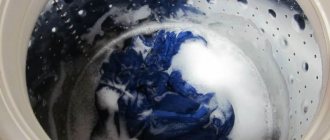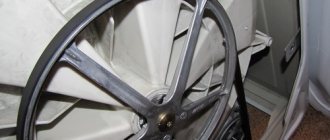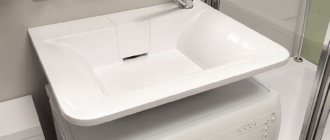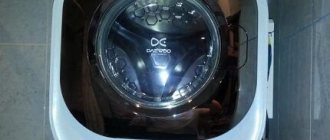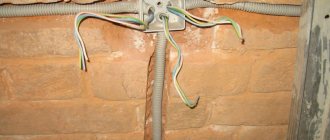Published: 14 Oct 2020
Although advertising promises with all its might that the washing machine operates silently, in reality this is not the case. SMA is a complex household appliance, some of its parts move and rotate, and therefore make noise. This is the sound of normal operation, but sometimes owners notice that something is knocking loudly inside the washing machine. It can rattle in different ways:
- a knocking sound appears during washing or is heard during the spin cycle of the washing machine;
- The knocking sound in the washing machine is heard only in the spin mode.
What to do if you hear unusual knocking sounds? First you need to exclude external causes.
Washing machine noise level standards
Depending on the model, washing machines vary in noise level. The noise limit is always indicated in the technical documentation. To reduce sound production, manufacturers equip devices with special systems. The amount of noise produced by the machine depends on the type of drive:
- belt version (gear drive) - volume varies within 60-75 dB;
- direct drive - the sound threshold is reduced to 50-70 dB.
Important! There are no absolutely silent SMAs, but the indicated audibility is quite comfortable for the user.
Identifying a problem by sound
The noise of the SMA intensifies during the spin cycle, since at this moment the drum rotates fastest. If the device has a noise level of 75 dB, excessive volume is completely normal. To determine the fact of a malfunction, listen to the sound:
- increasing, uncharacteristic rumble with each wash;
- very strong vibrations during the spin process;
- a loud noise that sounds like grinding, banging, or clanging.
Metal parts of things can lead to similar sounds. But constant violations indicate serious and minor failures.
When the shaft, oil seal and bearing wear out, screens are accompanied by a change in the color of the water during draining, rusty spots on clothing, leaks and jamming of the drum. Identifying the broken part and fixing it requires professional diagnostics. You can only identify common problems yourself.
The tank is not secured properly and a counterweight is created.
It is the counterweight that is responsible for ensuring that the tank is well fixed in the washing machine. It is secured with ordinary screws, which may simply loosen over time.
This causes increased noise. It is possible to determine that the fastenings are loose by visual inspection. To do this, you just need to remove the cover of the machine.
If after the screws were tightened the machine stopped making noise, then that was the reason. If this does not help and the noise when the machine operates continues, then this may indicate more serious problems that are best dealt with by a specialist.
You may be interested in another of our articles about malfunctions of household appliances - why the washing machine does not work.
Causes of noise in the washing machine and their elimination
If your household washing machine makes a lot of noise when spinning, the reason is due to improper operation. Extraneous noise appears when the drum is overloaded with things.
There are a number of other breakdowns that lead to clatter and noise from equipment.
Incorrect installation
Improper installation can be the main reason for the automatic machine rattling. Even a slight tilt provokes vibrations when the drum rotates at 800-1000 rpm. The imbalance in combination with centrifugal force leads to very loud knocking, vibration and swaying of the body. The problem is solved by leveling the equipment horizontally using a building level. Important! A loud knock also occurs when the machine is placed on the floor with a strong deflection.
Foreign object hit
If there are foreign objects in the drain pipes and drum, the operating washing machine makes noise, but during the spin cycle these sounds are heard most clearly.
There may be coins, metal fasteners and buttons inside the device that interfere with normal operation. The problem is solved by freeing the drum from small things and cleaning the drain pipes and channels. Sometimes small objects fall between the drum and the heating element and are removed by disassembling the housing. At the same time, cleaning of debris and scale is carried out.
Interesting to know! According to statistics from service centers, over 80% of calls are related to foreign objects getting into the mechanism of the equipment.
The transport bolts are not unscrewed
Manufacturers of washing equipment pay special attention to transportation safety. During transportation, the SMA drum is fixed with special fasteners to avoid loosening during movement.
You need to install the equipment only after unscrewing the bolts. Out of ignorance, users forget about them. The result is a loud noise from the device when it first starts up. After unpacking the washing machine, it is important to pay attention to the following:
- the drum is fixed with bolts on 4 sides;
- all fasteners must be removed;
- The fasteners should be unscrewed carefully so as not to damage the equipment casing;
- the bolts are unscrewed counterclockwise.
Check the transit bolts
Advice! Do not throw away the transport fasteners - you will need them the next time you transport the automatic machine.
Damaged bearings
If the washing machine rattles during washing and spinning, the problem is damage to the bearing.
Failure of the element occurs due to wear of the oil seal, which prevents moisture from entering. Leaking water causes corrosion on the bearing. The problem is defined as follows:
- rusty streaks appear on the outside (on the back cover of the tank);
- the drum moves unevenly;
- In spin mode, the machine makes a strong hum and whistle.
The problem is resolved by replacing the part.
Pulley loosening
When a noise with intermittent clicks occurs in a household washing machine during a fast spin cycle, this is due to a weakening pulley. The problem is not considered dangerous, and you can fix it yourself. To do this, open the back cover and tighten the loose bolt. Important! A weakened pulley leads to increased noise even at low speeds.
Uneven placement of counterweights
Counterweights on an automatic machine are needed to balance and reduce centrifugal force during drum rotation. If they are missing or malfunctioning, the device wobbles very much. The counterweight system is unevenly positioned due to manufacturing defects or is a consequence of improper transportation. If the element is damaged, it should be replaced.
The counterweight is loose
Loosening of the counterweights occurs after 5-7 years of intensive use of the SMA. The system is tightened, after which the noise is eliminated.
The seal does not fit the hatch size
Sometimes noise in a working washing machine appears when the filled drum rotates. Creaks and whistles, as well as the sound of rubber rubbing, appear immediately when you first start up new equipment. The breakdown is not a manufacturing defect and is not caused by the user. The rubber seal just doesn't fit the hatch door. It's worth changing. To save money, you can use sandpaper to sharpen the edges of the seal. Important! A problem of this nature occurs only in budget models.
Rotation shaft failure
If after some time the washing machine begins to make a lot of noise when washing or spinning, you need to pay attention to the fasteners and the unwinding system.
A broken rotation shaft prevents a tight fit of the drum. The part makes a noise, especially at high speeds. The shaft is a very strong part, but it wears out or becomes deformed when moisture gets into the inside of the housing. The breakdown is eliminated by replacing the part. It is best to use the services of a specialist.
DIY machine repair
To repair a machine yourself, you need to know its structure and operating principle. As a rule, repairs involve replacing old parts with new ones. When troubleshooting, you must first disconnect the machine from the power supply.
To replace parts yourself, you need to have a standard set of tools, and to repair the control board or electronics, you may also need a soldering iron.
Cleaning the drain filter
The first thing a washing machine owner can do is clean the filter. It often happens that small items of clothing or threads get there, which subsequently prevent the water from draining from the washing machine. To do this, you need to open the small cover located at the bottom of the machine and unscrew the small plastic plug using pliers.
After this, you need to clean the filter and rinse it under running water.
Cleaning the fill filter
This filter is located in the water intake hole. It can become clogged with small particles of dust or sand. To do this, you need to unscrew the inlet hose and use pliers to pull out the filter - a small plastic mesh that needs to be rinsed under water.
Replacing the heating element
If the repair involves replacing the heating element, you must first remove the back cover of the machine. Then disconnect the terminals and use a multimeter to check the element for functionality. The faulty heating element must be unscrewed using a wrench. After the old heating element is removed, you need to replace it with a new one. Be sure to install all parts in the correct order.
These are the most common types of repairs that you can easily carry out yourself. For more serious damage, it is better to contact a specialist.
Tips for avoiding malfunctions
- Observe the permissible load during washing - leave the drum one third empty.
- Perform preventative cleaning between work cycles.
- Try to use programs with high water heating as little as possible.
- Open the door after each wash to allow the machine to dry.
- If you wash several times a day, take breaks of 30 minutes.
- Leaving the washing machine idle for a long time causes the lubricant to evaporate and dry out.
- For budget models, components quickly wear out or wear out.
- Follow the rules for transportation, installation and connection to communications.
Watch the video about why the washing machine is noisy
Call the master
A technician will come out for diagnostics and repairs upon prior request. You can make a call by phone or through the feedback form on the website. Provide the service manager with the following information:
- Make and model of the washing machine (see the instructions on the body).
- What happened, when, after what, the main symptoms of the breakdown (needed to select tools and components before leaving).
- Optimal time for repairs.
- Contact details.
The technician will tell you why the malfunction occurred and what to do only after visiting and inspecting the washing machine. Most breakdowns are fixed within 1-2 hours; removal of equipment to our service is not required. Immediately after the repair is completed, the washing machine will be ready for use. In rare cases, repairs may require more time and a return visit from the technician. We are ready to order any components and perform complex software repairs, but this often increases the work time.
The drum fell off
Symptoms: When turned by hand, the drum makes squeaking sounds.
If you hear grinding and squeaking noises when turning the drum, this most likely means the bearings are worn out. Rock the drum back and forth: if you feel play, it means the drum has moved from its place and a gap has formed between it and the hatch. You can, of course, still check with a spin at maximum speed, but there is a risk of completely breaking the machine.
The reasons may be in the drive belt (flying off, worn out), bearings, shaft deformation, breakage of springs or shock absorbers holding the tank. And if you can still handle the belt yourself, then it is better to entrust the repair of the rest to a professional.
Drain pump as a cause of breakdowns
Does the washing machine knock less when spinning, more when draining, and does its sound resemble a transformer? The point is the drain pump, it is also popularly called a pump. The filter of this pump may be clogged. You can try to clean it if there is no scale. At the same time, check the pipe for the presence of foreign objects and dirt.
If the pump bursts, it is eaten away by substances from washing powders, then this means a complete failure of the pump. Replacement of such a broken part is mandatory. Take off the old one so that you can go to the market or plumbing store with it and choose the same one. If, after replacing the pump, the machine still makes sounds and knocking, and the spin mode is not locked, check for all other types of breakdowns.
Washing machine drain pump
The surge protector is unscrewed
A fairly common cause of knocking noise in a washing machine is a loose power filter. This device is necessary so that the electrical impulses generated during the operation of the washing machine do not turn into parasitic interference from the household electrical network of the apartment. Simply put, so that the lights in the house do not blink due to the constant and frequent switching on and off of the electric motor and heating element of the washing machine.
Network filter
In fact, this defect is not considered a serious breakdown, since it does not lead to further damage to the mechanisms of the washing machine. Physical impact from vibrations and shocks on the wires and the surge protector housing can lead to breakdown. As a result, anyone who touches the washer may receive a noticeable shock.
To eliminate the defect, just screw the surge protector into place. For most models, it is located at the top of the case near the hole for the power cord. To access, you need to remove the top cover, as mentioned earlier.
Other troubleshooting options
Have you decided what the problem is for the normal functioning of a machine that makes noise during the spin cycle? Re-inspect. What other symptoms did you see? After all, it is not only noise that indicates a failed part of the device. Start looking for additional reasons by looking at recently machine-washed clothes to see if there are stains on the items after washing or if you might notice anything else unusual.
If there are noticeable stains on freshly washed clothes, it is worth thinking about the reasons and possible speedy repairs. Second symptom: the holes are closed (machine lid, filter), but there is dripping from below. Water should not flow from a closed machine. If this happens, a clogged oil seal is to blame. When the drum breaks down noticeably prevents it from spinning, this is a sign that again points to the bearings, the washing function is impaired.
Foreign objects
Foreign objects get behind the moving parts of the machine from the pockets of trousers, jackets and other things placed inside for washing. But this breakdown is easy to fix. You just need to remove the heating element without pulling it very hard out of the machine. A part or other small object that accidentally falls behind it will be clearly visible to the naked eye in this position.
Foreign object between drum and tank
In some models of washing machines, manufacturers have provided convenient valves through which such things fall into the filter. In this case, just find the sump and its cover (it looks like a small hatch, located on the front). Open the hatch you find and you will see objects that are causing the buzz in the bathroom.
Unevenly distributed laundry
This problem is typical for older models. Modern devices practically do not rattle, of course, if they are in good working order and installed correctly. Good alignment is facilitated by the presence of electronics, which allows you to distribute things more evenly and prevent imbalance in the drum. Old devices cannot assess how well the drum is centered, and whether there are crumpled laundry in it. Spinning occurs in any case, and then the drum may knock on the walls or other elements of the washing machine.

